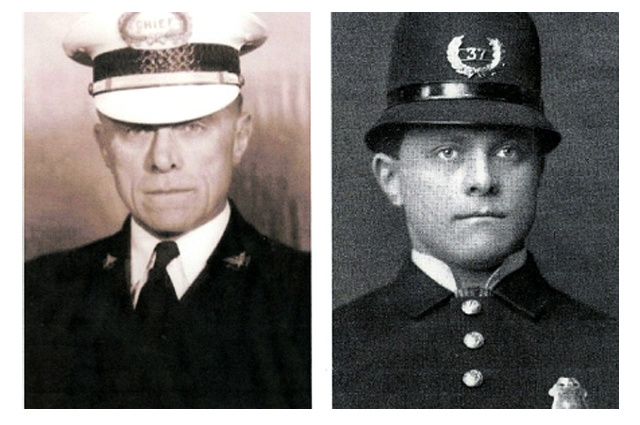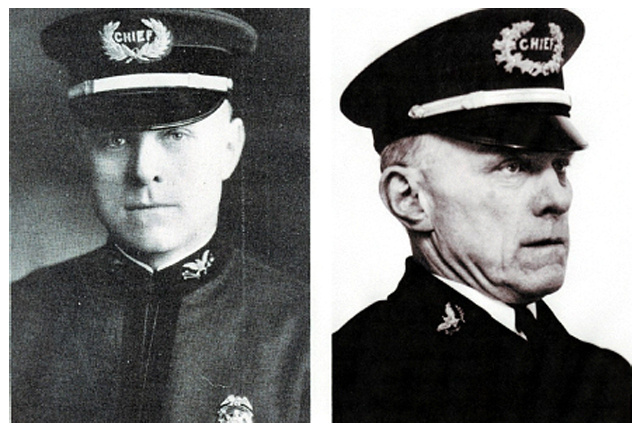|
The Nation's Dean of Police
The Nation's Dean of Police Chiefs - Rudolph Wurstner
--by retired Dayton Sgt. Steve Grismer
In December 1902, Dayton was Montgomery County’s only incorporated city. Its police force had been in existence as an organization less than three decades. It had two horse-drawn patrol wagons, 70 patrolmen and little else. Even though Dayton’s Wright brothers would have a historic first flight the following year - a magnificent advent to the 20thCentury’s age of modern transportation - local patrolmen simply sauntered police beats on worn shoe leather. These men were conducting basic foot patrol no differently than constables had 70 years earlier, making their rounds 12 or more hours every day with only one day off every two weeks. Into this glamorous form of public service walked 21-year-old Rudy Wurstner.

Rudolph F. Wurstner would have a police career like no other in the annals of the Dayton Police Department, setting standards of excellence and progress in law enforcement. His career would see the greatest growth in Dayton’s history and span an extraordinary period of hardship and achievement. By the time Chief Wurstner retired 47 years later on July 25, 1949 the City’s population had nearly triple in size to 244,000 and become the 40thlargest city in the nation.
Chief Wurstner was defined by his character but also his longevity and the incredible times in which he served. Born on August 5, 1881, the young Wurstner was appointed as a patrolman in 1902, issued a badge, Bobby-style hat, whistle and nightstick. Hopping street cars was the method of rapid transit for police in those days. Ptl. Wurstner’s earliest walking beat was along W. Third Street at the Wright Cycle Shop. He was a veteran patrolman by the time of the devastating Great Flood of 1913. Promoted to the rank of sergeant in 1915, he continued his police duties as The Great War (WWI) raged in Europe.
By 1920, Rudy Wurstner was a member of the police command staff at a time when two Model “T” Fords comprised the entire police fleet. In 1925, after over 22 years of protective service to the citizenry of Dayton, Inspector Wurstner rose to the position of Chief of Police, replacing a man that the City Manager found to be unfit for the office after a very turbulent 2½ years. Wurstner would bring stability to the division of police in remarkable fashion. He led the police for the next quarter century through Prohibition, the Roaring Twenties, the Great Depression and beyond… a period extending years on either side of Franklin Roosevelt’s historic presidency.
By 1935, Chief Wurstner had become the Nation’s Dean of Police Chiefs and remained the United States most senior metropolitan police commander for the next 14 years! It was a time when gangsters assailed the Midwest and Dayton was not immune. Wurstner’s Dayton police force arrested John Dillinger in 1933 and investigated George ‘Bugs’ Moran, who was convicted of a local holdup in 1946. Wurstner oversaw the safety of the local public throughout the anxiety of WWII and during the rapid industrialization of the city that brought forth one of the country’s more violent labor strikes requiring military intervention – the 1948 Univis Strike in north Dayton. Through it all, Chief Wurstner maintained a firm hand and, when he retired in 1949, his tenure as a major municipal police chief had been equaled by only three others in U.S. history.

During Rudy Wurstner’s career as a police commander, more than 70% of Montgomery County’s population resided within Dayton proper and his efforts to modernize local law enforcement was pivotal to the region. Two of his more progressive endeavors were:
-
In 1940, in preparation for a local visit by President Franklin Roosevelt, Dayton became the first police department in the nation to equip its entire police fleet with two-way radio communications… a fleet that would number 50 motorized vehicles by 1949.
Chief Wurstner was a modest man who preferred not to talk about his past exploits, which he termed “water over the dam.” “I don’t enjoy reading about what other men have said they have done in capturing notorious robbers, so I [don’t] indulge in any kind of boasting myself.” He was respected by his troops like no other chief. He was known for his keen sense of fairness. A veteran patrolman once said that if you were right “you had a champion… in your corner. If you were wrong, you could expect to be handled in the same firm way.” Chief Wurstner always held that a police officer should “be a square shooter and observe the golden rule.”
The respect Chief Wurstner received from his troops had as much to do with his hands-on approach to policing as it did to his reputation for fairness and longevity of service. Even after his rise in command to chief of police, he would personally respond to crimes in progress and high-risk incidents. One early example was on December 16, 1925. In the afternoon of that day, Ptl. Perry Heywood was shot and wounded in a gun battle at 324 Bruen Street (near Ludlow Ave.). Chief Wurstner arrived on the scene moments after the shooting and arrested the shooting suspect, Pearl Shortill, a man who had also shot a second patrolman.
In the twilight of his career, Chief Wurstner was on the scene of the Univis Lens Company labor strike in north Dayton in the summer of 1948. Time magazine, in an article titled “Labor: Brass Knuckles”, described it as “a savage, three-month-old strike in which heads had been bloodied, stink bombs tossed at non-strikers [and] ribs prodded by police billies….” [sic] The size of the daily crowds grew to as high as an estimate of 10,000 with picket line support from Frigidaire, Delco and GHR Foundry workers. Rather than direct his troops from headquarters, Chief Wurstner was in the thick of the action. As old film footage reveals, the Chief was nose-to-nose with the labor leader in several heated exchanges. Both sides endured one of the more violent labor strikes that ultimately brought Gov. Thomas Herbert to Dayton and the emergency declaration for military response.
Even when the community was caught in tumultuous affairs, Chief always focused on his relationship with his community from his time as patrolman through his retirement as chief. He once said, “On my beat I always made it a habit to drop in and learn to know those who ran business establishments or persons in the neighborhood, whether they were cobblers or bankers.”
At the close of anincredible 47-year career, he remarked, “I value nothing more highly than the confidence I feel I have gained from the public I have tried to serve.”
Chronicle of Events transpiring during Chief Wurstner’s Police Career
-
In 1927, one of Chief Wurstner’s commanders and good friends, Capt. John C. Post died in a gun battle, one of 11 Dayton officers tragically killed in the line of duty during the Chief’s long career, nine from gunshot wounds. The Dayton Fraternal Order of Police is named in honor of Capt. Post.
-
1931-1939– Having actually started during Prohibit and the Roaring 20’s, the Gangster Era defined two decades of bootlegging, underworld crime, bank hold-ups and high-powered weapons.
-
In 1942, local industrialization was at full vitality earning Dayton, a major manufacturing town, the moniker of “Little Detroit”. Automotive factories drew workers from around the country, contributing to Dayton becoming the nation’s 40th largest city and ranking it third in the U.S. in cars per capita.
Key Dates
Born: August 5, 1881
Police Appointment: December 1, 1902
Promotions:
-
Sergeant: February 3, 1915
-
Police Inspector: March 1, 1920
-
Chief of Police: June 18, 1925
Retirement: July 25, 1949
Death: July 12, 1969
|
|
|